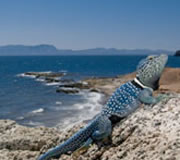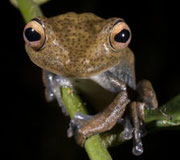|
OPPORTUNITIES
Purchase Photographic Prints
and Support Our Work

Help Save Animals and Ecosystems: Donate Now!

|
Documenting Biodiversity
Ecuador and Tropical Biodiversity
Those areas of Earth with the highest biodiversity and the greatest environmental crises have been identified as biodiversity hotspots. One such hotspot is located on the western coast of Ecuador in South America. This region has experienced over 95% deforestation—only fragments of previous habitats remain. Many species unique to the region (endemics) are likely being lost in the process. However, much of the biodiversity in this imperiled region remains unknown to science. This project will document the biodiversity of reptiles and amphibians at several sites in western Ecuador. The goals of this project are threefold: to document diversity of reptiles and amphibians, to describe new species, and to publish a field guide of the region.
Tropical ecosystems are the most biodiverse on earth, and Ecuador exemplifies this diversity. Roughly 8% of amphibian species, 5% of reptile species, 8% of mammal species, and 16% of bird species in the world are found in this diminutive country (Coloma and Ron 2001, which comprises only 0.2% of the world’s land area. To put this into perspective, this area is about the same size as our home state, Arizona. Hectare by hectare, Arizona is the most biodiverse state in the Union. Tourists flock here from all over the world to see 14 species of hummingbird, another 14 species of rattlesnake, as well as unusual tropical species like trogons and vine snakes. With so much to see, it is no wonder Arizona gets so much attention! However, comparing Arizona to Ecuador is no comparison at all. Visitors can enjoy 140 species of hummingbird in Ecuador. Indeed, for most groups of organisms, Ecuador is home to more species than all of the United States and Canada.
The threats to biodiversity in Ecuador are nearly as varied as the diversity itself. Despite popular belief, the Amazon Rainforest is not as threatened most other tropical ecosystems. While the rate, on a hectare (or square mile) basis, is alarming (Skole and Tucker, 1993), the majority of the Amazon Basin is largely intact. Threats in eastern Ecuador include oil exploration and timber harvesting. And these industries have definitely left an indelible mark on the westernmost reaches of the Amazon. However, the situation on the coast of Ecuador is much more of a crisis. Only an approximate 2% of forests are left intact (Dodson and Gentry 1991). Deep valleys and vast mountains are denuded. The majority of the destruction in the west comes from agriculture: coffee, banana, citrus and cattle are huge export businesses. These threats, combined with the unique nature of biodiversity in western Ecuador have led scientists to deem this region one of the world’s ‘biodiversity hotspots’—an area in dire need of protection (Myers et al., 2000).
Documenting Biodiversity
Despite such proclamations, scientific efforts lag far behind conservation necessities. The few remaining tracks of forest are largely unexplored by many specialties of science. The reptile and amphibian fauna, while assuredly rich and diverse, is known only from a few collecting localities, and published information of the region is particularly depuaperate (but see Lynch and Duellman, 1997 for a refreshing counterexample). Clearly, basic ecological information is needed for these understudied taxa in these imperiled ecosystems, and our work aims to provide just that; ultimately helping to save the flora and fauna of Ecuador.
Additional Reading
These are a few general resources that explain these ideas in more detail.
A Neotropical Companion, by Kritcher 1998. Available at Amazon.com used for about $10.
Megadiverse Ecuador by Luis Coloma and Santiago Ron. 2001. This is a nice coffee table book with plenty of great photographs of herps, birds and mammals.
The Diversity of Life by E. O. Wilson. 1992. This is a good popular read on patterns of biodiversity as well as conservation concerns with an emphasis on the tropics.
Conservation International’s web page for the Tumbes-Chocó-Magdalena : This site has background about why our study sites rank among the Biodiversity Hotspots in the world, in particular need of protection.
Dodson, C. H. and A.H. Gentry. 1991. Biological Extinction in Western Ecuador. Annals Missouri Botanical Garden 78:273-295. Lips, K. R., J. K. Reaser, B. E. Young and R. Ibanez. 2001.
Amphibian monitoring in Latin America: a protocol manual. Herpetological Circular No 20.
Lynch, J.D. and W. E. Duellman. 1997. Frogs of the genus Eleutherodactylus in Western Ecuador: Systematics, ecology, and biogeography. University of Kansas, Natural History Museum, Special Publication 23.
Myers, N., R. Mittermeier, C. G. Mittermeier, G. A. B. da Fonseca and J. Kent. 2000. Biodiversity hotspots for conservation priorities. Nature 403:853-858.
Skole, D. and C. Tucker. 1993. Tropical deforestation and habitat fragmentation in the Amazon: satellite data from 1978 to 1988. Science 260: 1905-1910.
Stevens, G. C. 1989. The latitudinal gradient in geographical range: How can so many species coexist in the tropics? American Naturalist. 133:240-256.
<<Previous 1 2 3 4 5 6 7 Next>>
|
ECUADORIAN BIODIVERSITY PROJECT
Project Home
Documenting Biodiversity
Species Discovery
Study Sites
The Work
Travel
Apply
Find out how you can participate in a research expedition to the rainforests of Ecuador.
Meet some of our previous participants in our Ecuador program.
See Photo Galleries of our Ecuadorian Study Sites & Field Crews:
Summer 2008
January 2007
May 2007
August 2007
January 2008
|

